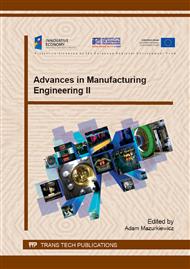p.15
p.21
p.27
p.34
p.41
p.47
p.54
p.61
p.71
Optimization of CrN/CrCN Gradient Coatings
Abstract:
The paper describes the optimization procedure supporting the designing process of geometry of gradient coatings basing on numerical simulation of internal stress and strain distributions in the coating and substrate. In mathematical model the gradient coating is represented by the so-called transition functions describing the change of physico-chemical parameters such as Young's modulus, Poisson's ratio, thermal expansion coefficient and the density as a function of the spatial variables. The object of optimization is system composed of a CrN/CrCN gradient coating and Cr interlayer between the CrN /CrCN coating and the steel substrate deposited on nitrided 4140 steel substrate. Decision variables are: the parameters of the of curvature of transition function , thickness of gradient coating and the thickness of the Cr interlayer. Optimization was carried out under pre-defined fixed continuous external loads and created decision criteria were the functions of the state of stress and strain in the coating and the substrate. Using the optimization procedure the sets of optimal parameters (Pareto sets) of the PVD gradient coating/nitrided substrate systems, due to the adopted decision criteria were determined. The analysis of the obtained optimal solutions (Pareto-optimal sets) was carried out using the "utopian solution method". It was also examined the technological stability of the Pareto-optimal solutions (nondominated) by analyzing the number of direct neighbors of these solutions in the decision variables space.
Info:
Periodical:
Pages:
41-46
Citation:
Online since:
August 2015
Authors:
Price:
Сopyright:
© 2015 Trans Tech Publications Ltd. All Rights Reserved
Share:
Citation:


